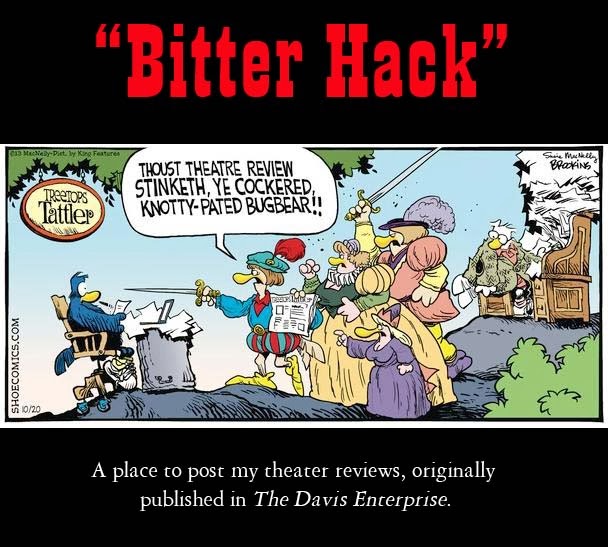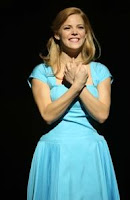“People are not comfortable with difference. You know? Fags, retards, cripples. Fat people. Old folks, even. They scare us or something... The thing they represent that’s so scary is what we could be, how vulnerable we all are...we’re all just one step away from being what frightens us. What we despise so...we despise it when we see it in anybody else.”
The character of the unlikable friend, Carter (Michael Wiles) has just summed up the message of Neil LaBute’s “Fat Pig,” currently running at Capital Stage, on the Delta King, under the direction of Stephanie Gularte.
“Fat Pig” is a one-act, four-person play which centers on the growing relationship between Tom (Shaun Carroll) and Helen (Christin [sic] O’Cuddehy), two people who meet, by chance, in a diner and discover that they love the same movies and the same books, they have the same sense of humor and they just seem to click.
The problem is that Helen is fat (I will resist the temptation to use euphemisms like zaftig or Rubenes-esque or “full figured”) and Tom is a tall, slim, handsome, successful businessman who has apparently used his looks to work his way up the corporate ladder. There is also an ex-girlfriend, Jeannie (Katherine C. Miller), who doesn’t realize she’s really an “ex” girlfriend and who can’t understand what Tom can possibly see in “that fat sow.”
As a fat person myself, I found a lot of disturbing things in the script of this comedy, particularly in the mean-spirited comments that Carter uses to describe Helen. (“She’s off to the bathroom...with a basket of dinner rolls hidden under her skirt.” “They didn’t just send her, did they?–not that she couldn’t eat for five...”) – and especially the audience’s laughter at the jokes. But that was LaBute’s whole point. His program biography talks of his own battles with weight (a battle he claims that he is now losing, after a successful period of high self esteem when he was able to stick with a healthy lifestyle.) He wants the audience to look at appearance and our feelings about people who are “different.”
Tom, Carter and Jeannie are the “beautiful people,” and yet they are seriously flawed and each of them, on some level is unlikeable. Helen is the “different one.” Yet she has a beauty about her which is unmistakable and ultimately she is the only truly “good” character in the play.
This is another strong cast for Capital Stage. Christin O’Cuddehy is magnificent. She has a self-assuredness that makes you look past her weight instantly. Like her character, she seems comfortable in her body and she knows she’s good. Her changing emotions throughout the play were beautifully handled, particularly at the end. It would be difficult to think of an actress who could have done this role better.
Shaun Carroll is a fussbudgety Tom, unsure of himself, knowing how much he cares for this woman, yet torn between his growing feelings for her and his fear of the derision he will receive at the hands of the rest of the world if he were to continue the relationship.
I want to say that Michael Wiles was terrible as Carter...but my negative feelings are only because he was such a good Carter. He created the perfect sleazeball, a snobby, snide, self-indulgent character who pretends to be Tom’s friend, but who is never there for him, except when he can have some fun at his friend’s expense.
Katherine C. Miller is a spitfire as the scorned Jeannie. Though she did a wonderful job in the role, I feel that LaBute’s scenes between Jeannie and Tom were overly long and repetitious. We never really learn much about their previous relationship (LaBute tantalizes us with whether there was actually a physical relationship or not), other than that it ended badly and Jeannie still hopes for a reconciliation.
While this is really a comedy, like LaBute’s other works (such as “Nurse Betty”), it has a distinct dark side to it. Throughout the evening, we wonder which will win out – will love conquer all, or will peer pressure force Tom to give up his one big chance at a meaningful relationship?
Throughout the journey, perhaps we can all learn a bit about ourselves and how we view the world around us, and give some thought to how we treat those who aren’t part of the “beautiful people.”
The character of the unlikable friend, Carter (Michael Wiles) has just summed up the message of Neil LaBute’s “Fat Pig,” currently running at Capital Stage, on the Delta King, under the direction of Stephanie Gularte.
“Fat Pig” is a one-act, four-person play which centers on the growing relationship between Tom (Shaun Carroll) and Helen (Christin [sic] O’Cuddehy), two people who meet, by chance, in a diner and discover that they love the same movies and the same books, they have the same sense of humor and they just seem to click.
The problem is that Helen is fat (I will resist the temptation to use euphemisms like zaftig or Rubenes-esque or “full figured”) and Tom is a tall, slim, handsome, successful businessman who has apparently used his looks to work his way up the corporate ladder. There is also an ex-girlfriend, Jeannie (Katherine C. Miller), who doesn’t realize she’s really an “ex” girlfriend and who can’t understand what Tom can possibly see in “that fat sow.”
As a fat person myself, I found a lot of disturbing things in the script of this comedy, particularly in the mean-spirited comments that Carter uses to describe Helen. (“She’s off to the bathroom...with a basket of dinner rolls hidden under her skirt.” “They didn’t just send her, did they?–not that she couldn’t eat for five...”) – and especially the audience’s laughter at the jokes. But that was LaBute’s whole point. His program biography talks of his own battles with weight (a battle he claims that he is now losing, after a successful period of high self esteem when he was able to stick with a healthy lifestyle.) He wants the audience to look at appearance and our feelings about people who are “different.”
Tom, Carter and Jeannie are the “beautiful people,” and yet they are seriously flawed and each of them, on some level is unlikeable. Helen is the “different one.” Yet she has a beauty about her which is unmistakable and ultimately she is the only truly “good” character in the play.
This is another strong cast for Capital Stage. Christin O’Cuddehy is magnificent. She has a self-assuredness that makes you look past her weight instantly. Like her character, she seems comfortable in her body and she knows she’s good. Her changing emotions throughout the play were beautifully handled, particularly at the end. It would be difficult to think of an actress who could have done this role better.
Shaun Carroll is a fussbudgety Tom, unsure of himself, knowing how much he cares for this woman, yet torn between his growing feelings for her and his fear of the derision he will receive at the hands of the rest of the world if he were to continue the relationship.
I want to say that Michael Wiles was terrible as Carter...but my negative feelings are only because he was such a good Carter. He created the perfect sleazeball, a snobby, snide, self-indulgent character who pretends to be Tom’s friend, but who is never there for him, except when he can have some fun at his friend’s expense.
Katherine C. Miller is a spitfire as the scorned Jeannie. Though she did a wonderful job in the role, I feel that LaBute’s scenes between Jeannie and Tom were overly long and repetitious. We never really learn much about their previous relationship (LaBute tantalizes us with whether there was actually a physical relationship or not), other than that it ended badly and Jeannie still hopes for a reconciliation.
While this is really a comedy, like LaBute’s other works (such as “Nurse Betty”), it has a distinct dark side to it. Throughout the evening, we wonder which will win out – will love conquer all, or will peer pressure force Tom to give up his one big chance at a meaningful relationship?
Throughout the journey, perhaps we can all learn a bit about ourselves and how we view the world around us, and give some thought to how we treat those who aren’t part of the “beautiful people.”


